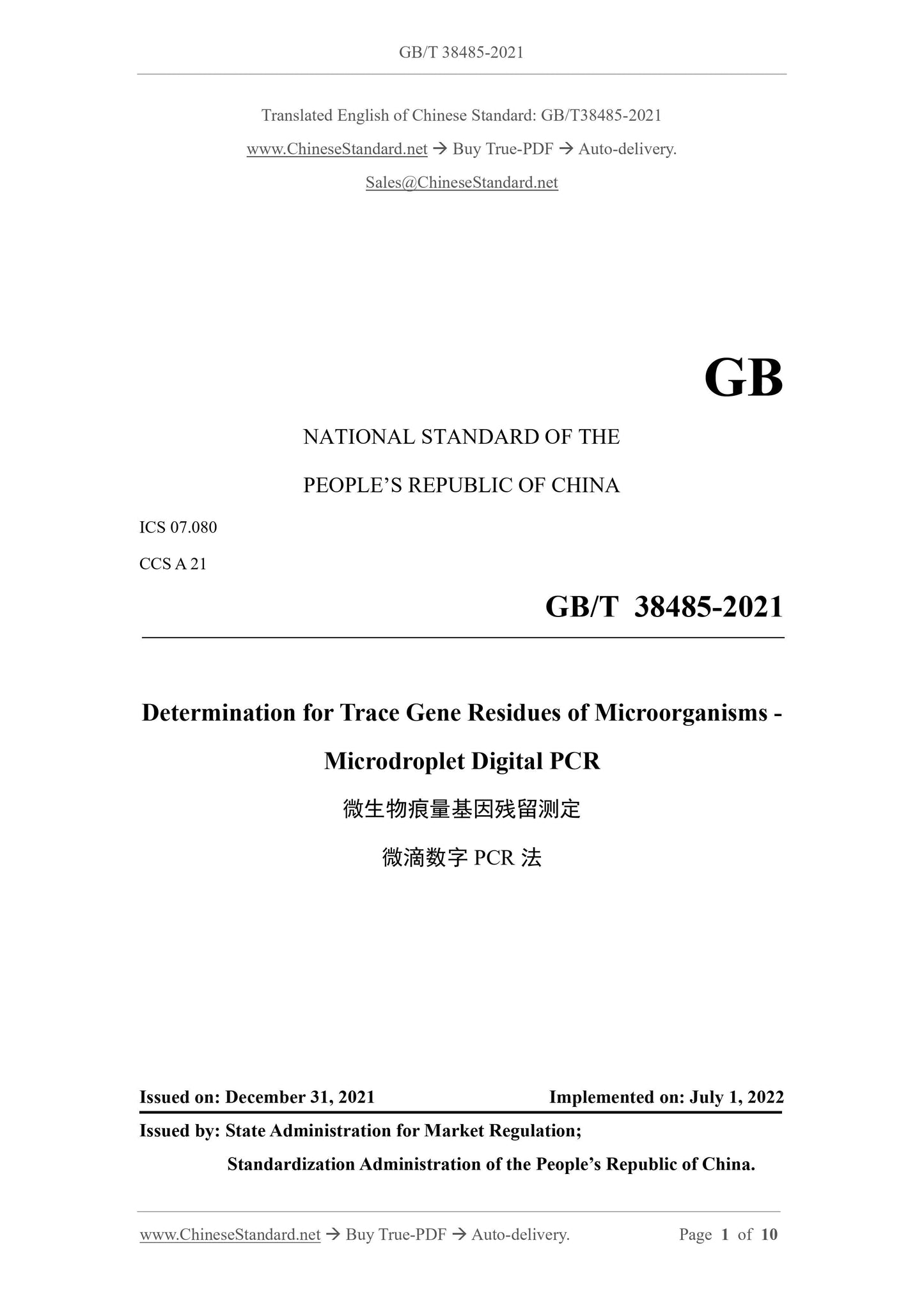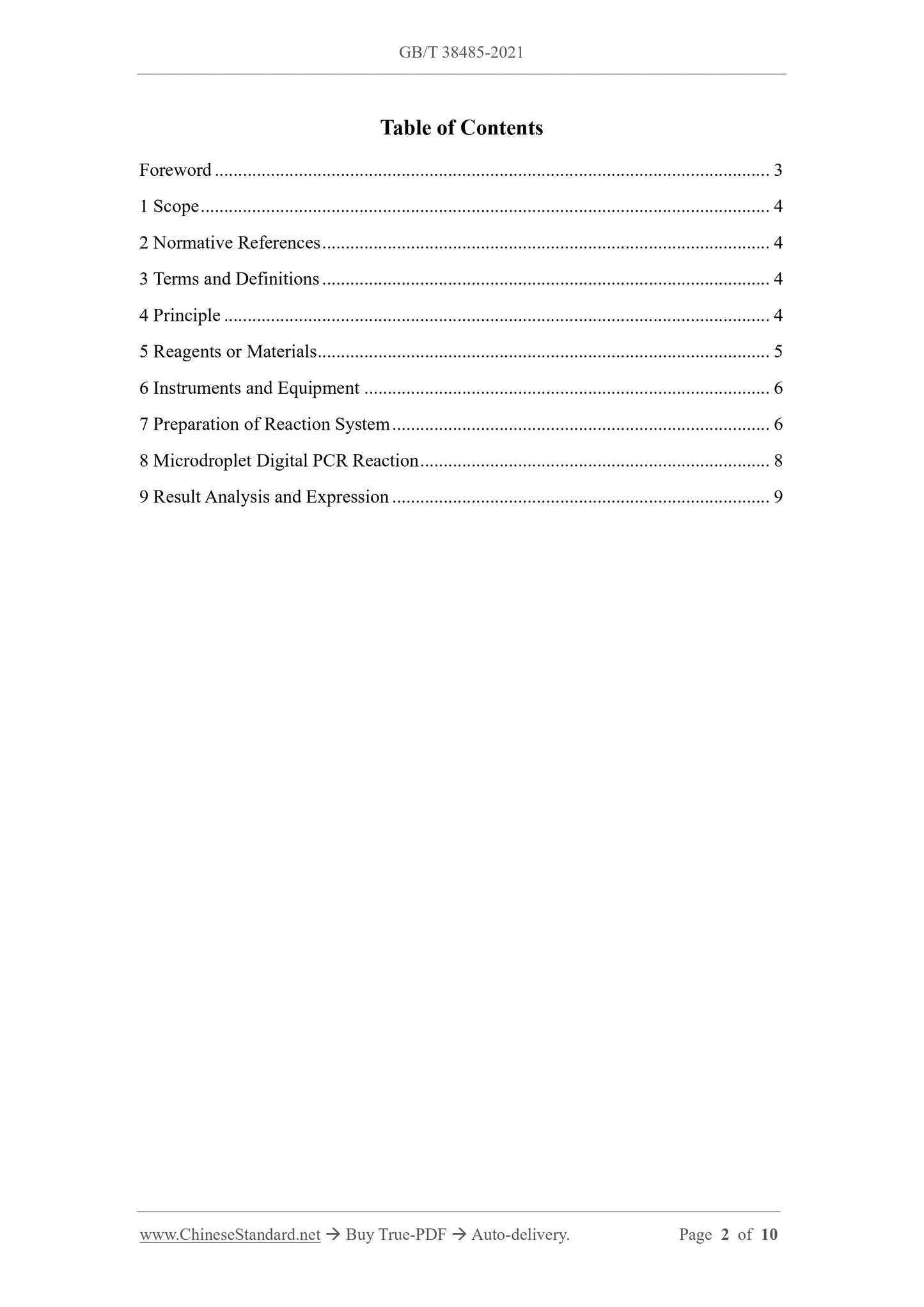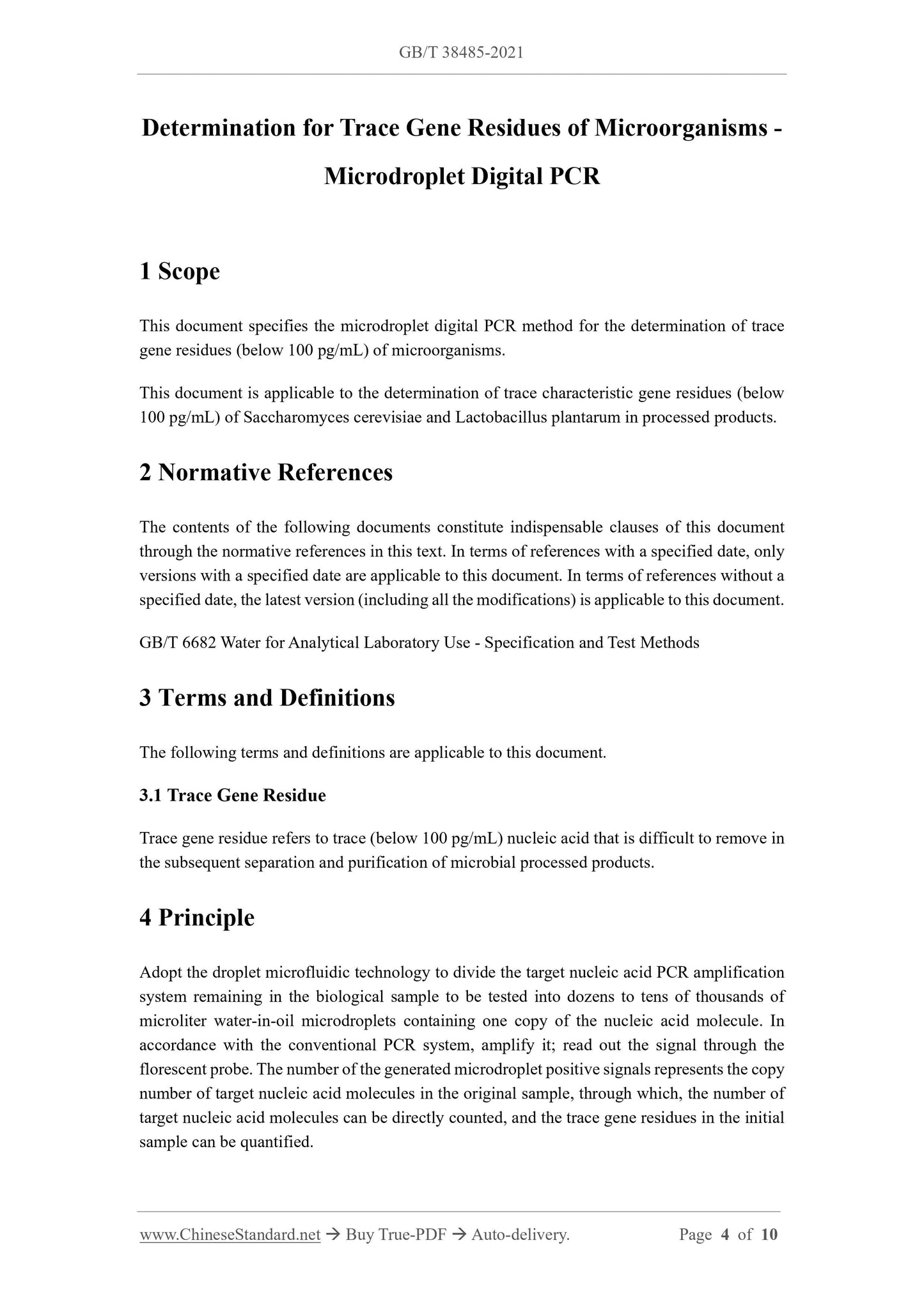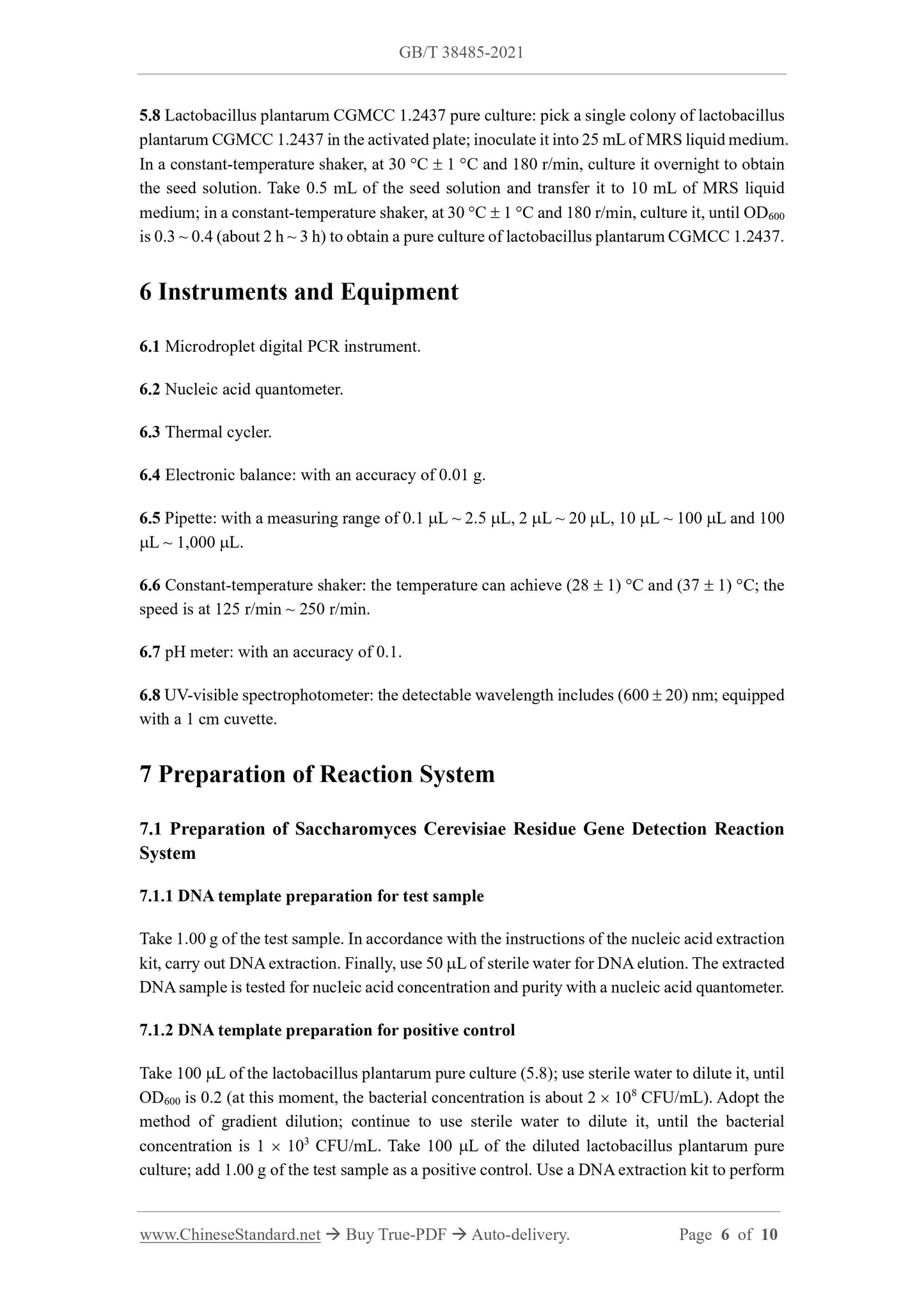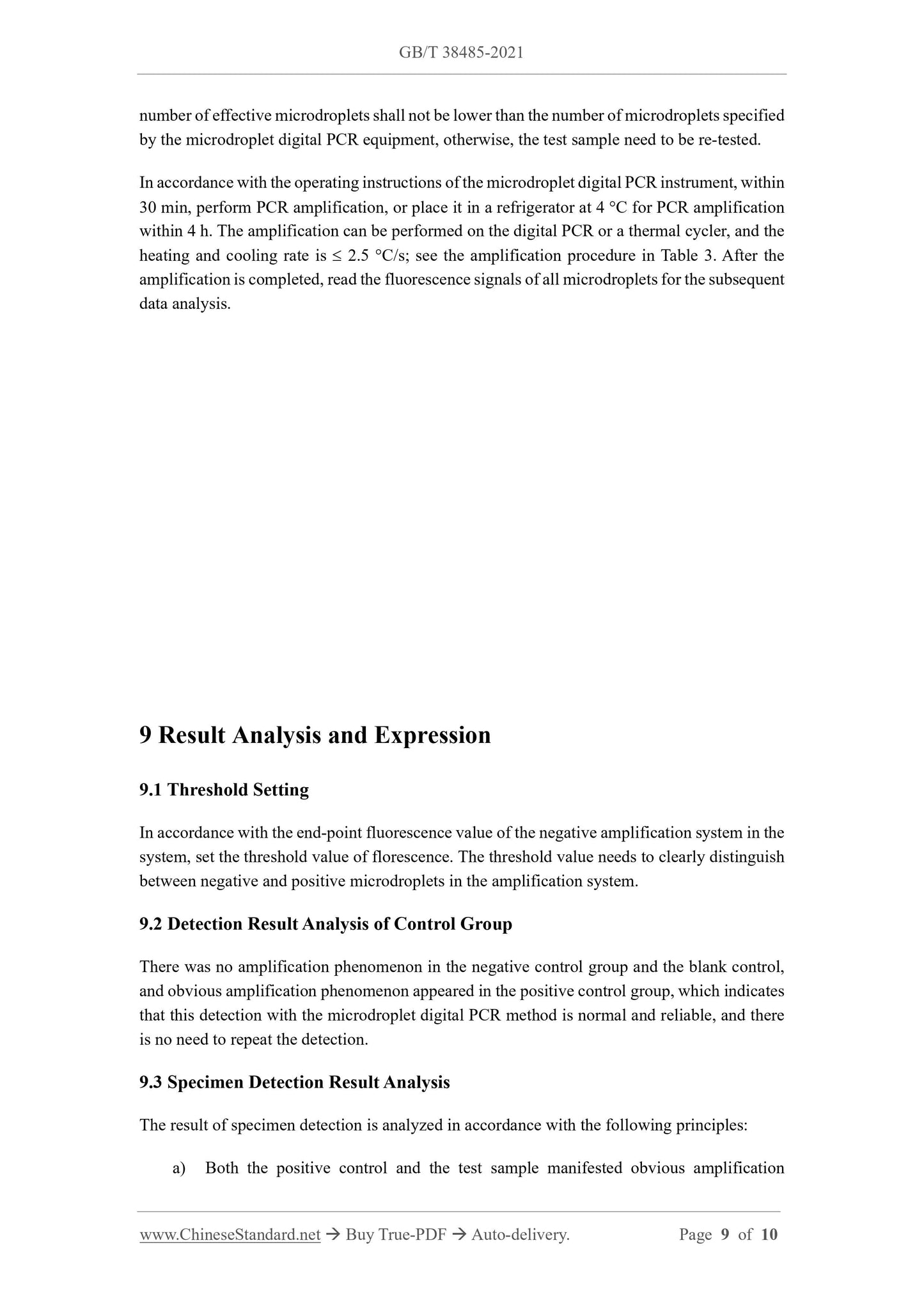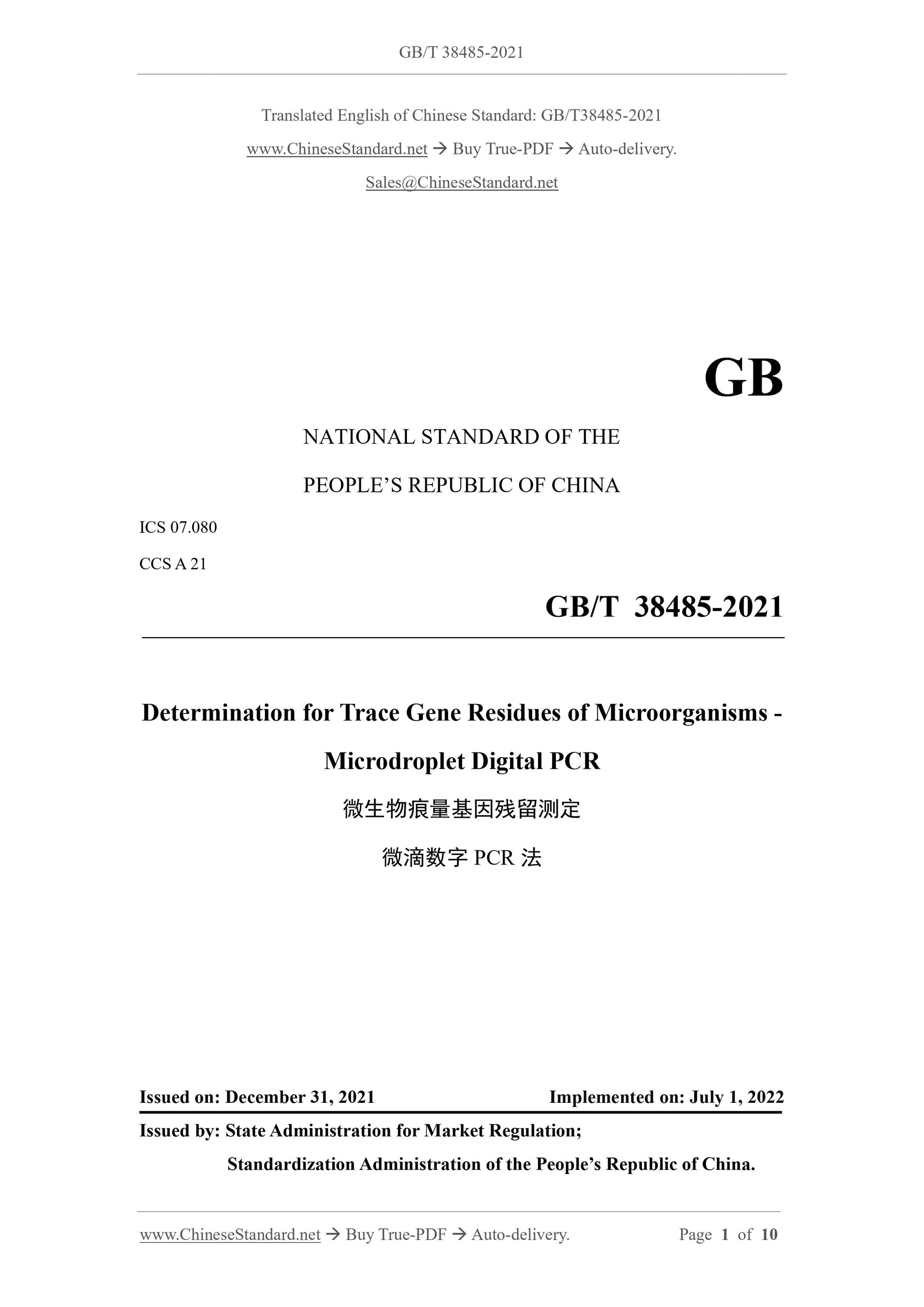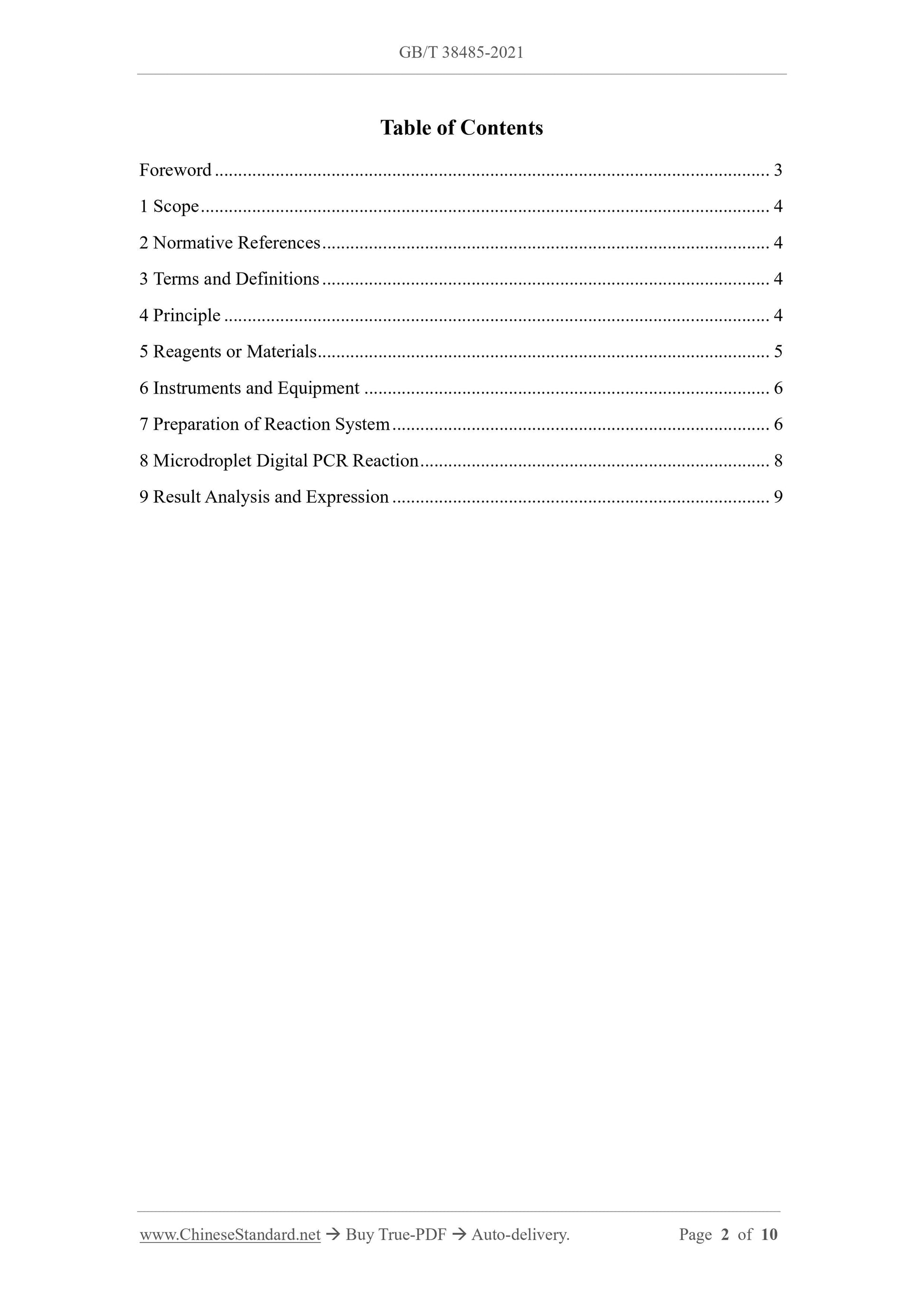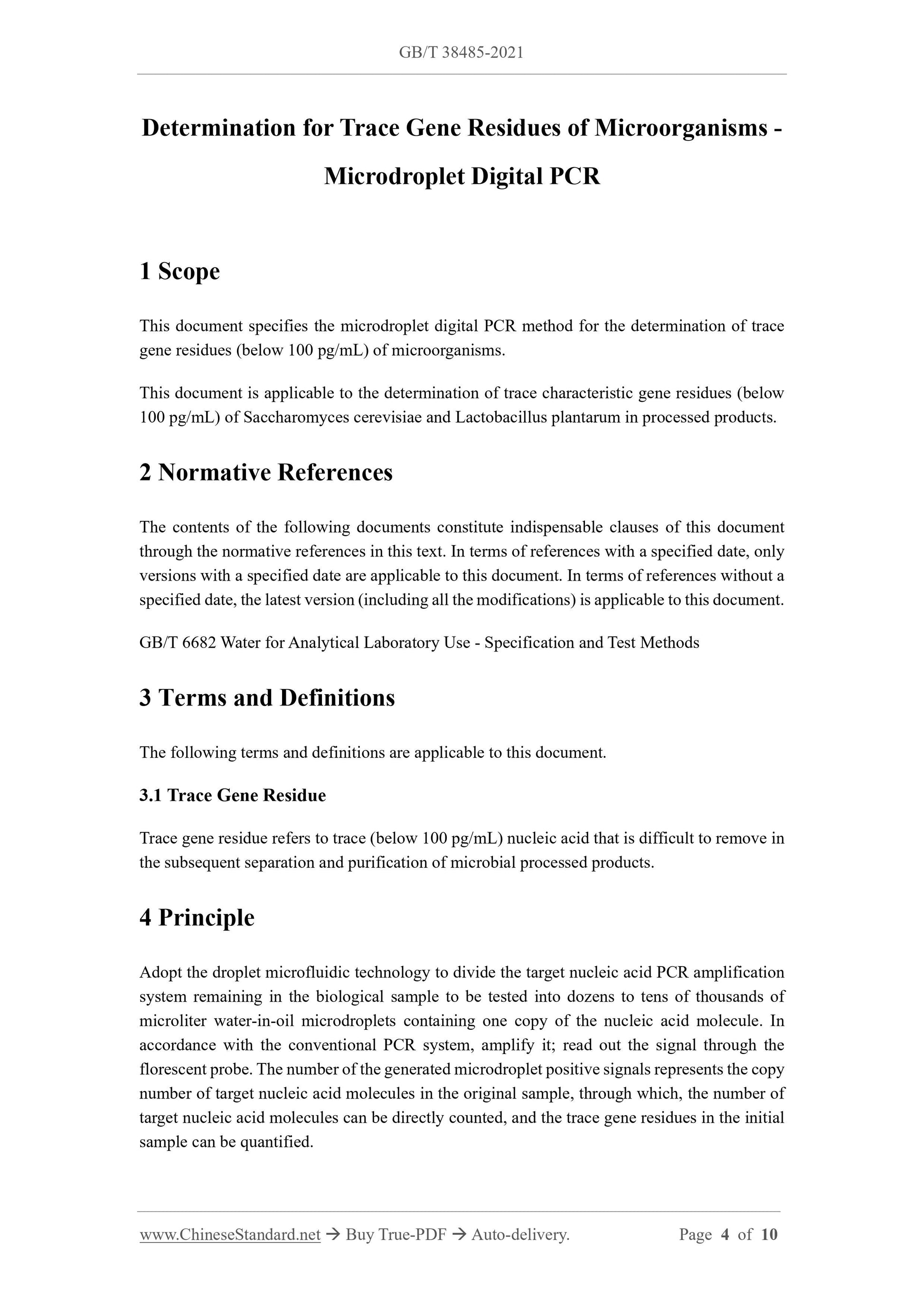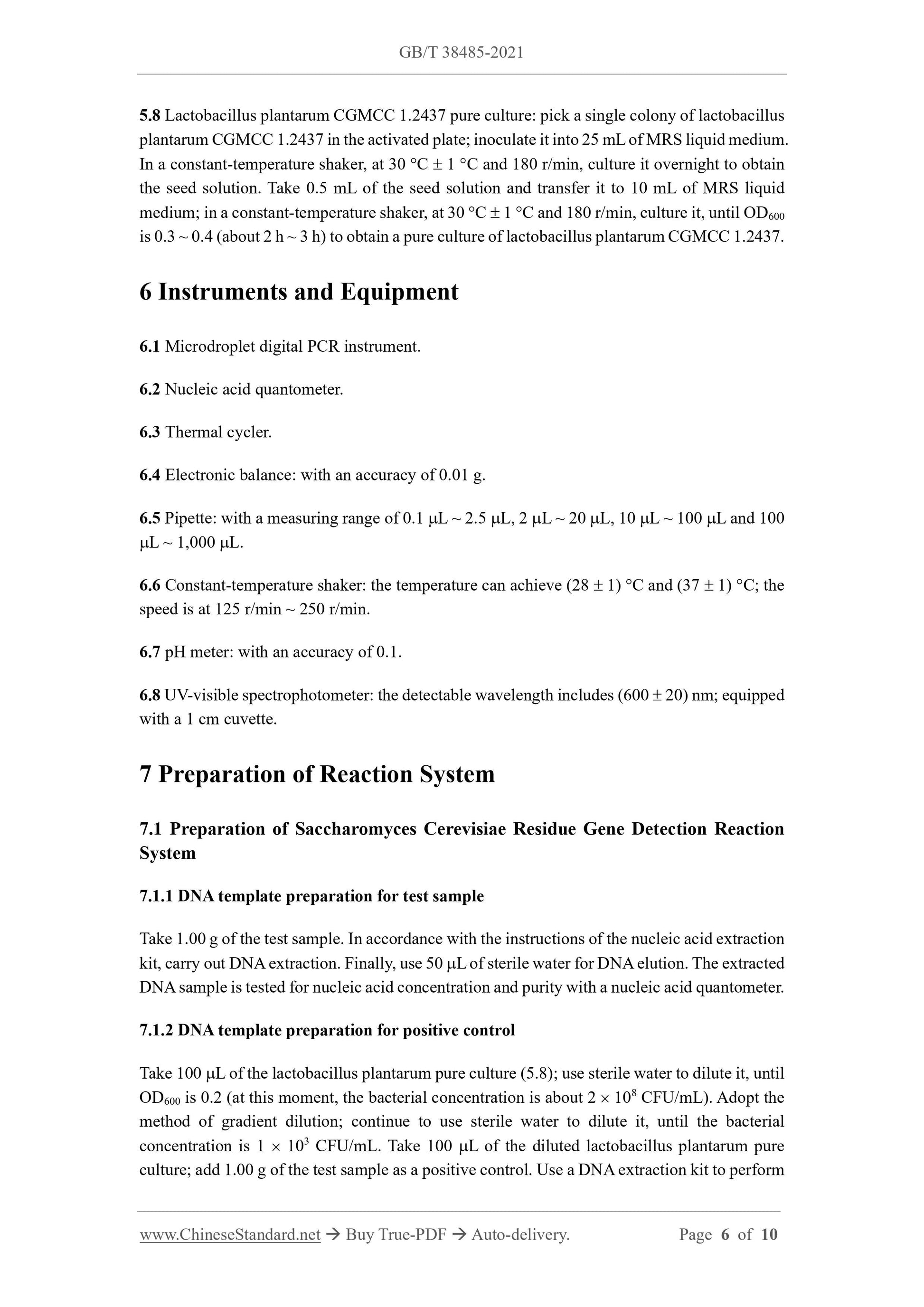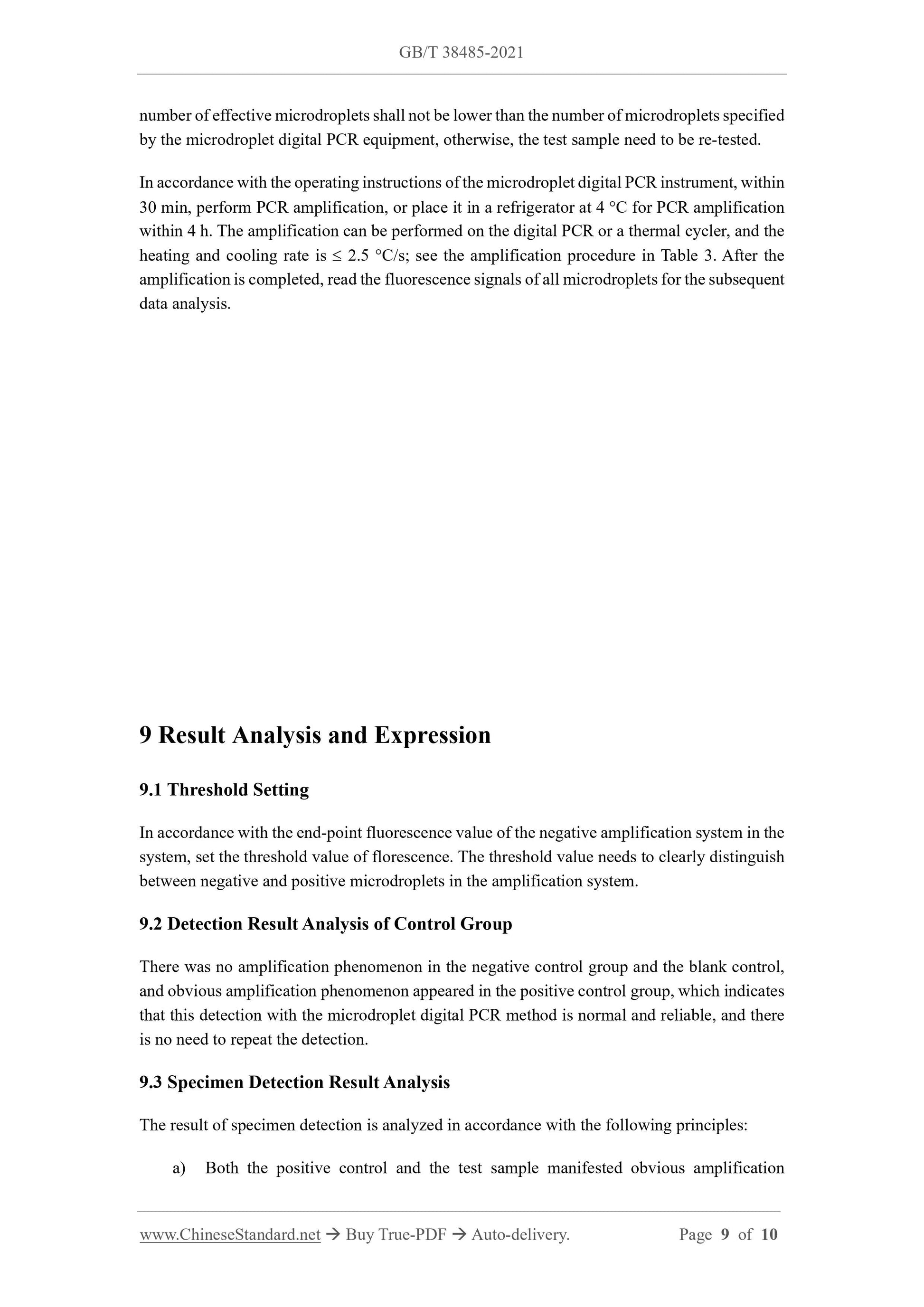1
/
su
5
PayPal, credit cards. Download editable-PDF & invoice in 1 second!
GB/T 38485-2021 English PDF (GBT38485-2021)
GB/T 38485-2021 English PDF (GBT38485-2021)
Prezzo di listino
$155.00 USD
Prezzo di listino
Prezzo scontato
$155.00 USD
Prezzo unitario
/
per
Spese di spedizione calcolate al check-out.
Impossibile caricare la disponibilità di ritiro
Delivery: 3 seconds. Download true-PDF + Invoice.
Get QUOTATION in 1-minute: Click GB/T 38485-2021
Historical versions: GB/T 38485-2021
Preview True-PDF (Reload/Scroll if blank)
GB/T 38485-2021: Determination for trace gene residues of microorganisms -- Microdroplet digital PCR
GB/T 38485-2021
NATIONAL STANDARD OF THE
PEOPLE’S REPUBLIC OF CHINA
ICS 07.080
CCS A 21
Determination for Trace Gene Residues of Microorganisms -
Microdroplet Digital PCR
ISSUED ON. DECEMBER 31, 2021
IMPLEMENTED ON. JULY 1, 2022
Issued by. State Administration for Market Regulation;
Standardization Administration of the People’s Republic of China.
Table of Contents
Foreword... 3
1 Scope... 4
2 Normative References... 4
3 Terms and Definitions... 4
4 Principle... 4
5 Reagents or Materials... 5
6 Instruments and Equipment... 6
7 Preparation of Reaction System... 6
8 Microdroplet Digital PCR Reaction... 8
9 Result Analysis and Expression... 9
Determination for Trace Gene Residues of Microorganisms -
Microdroplet Digital PCR
1 Scope
This document specifies the microdroplet digital PCR method for the determination of trace
gene residues (below 100 pg/mL) of microorganisms.
This document is applicable to the determination of trace characteristic gene residues (below
100 pg/mL) of Saccharomyces cerevisiae and Lactobacillus plantarum in processed products.
2 Normative References
The contents of the following documents constitute indispensable clauses of this document
through the normative references in this text. In terms of references with a specified date, only
versions with a specified date are applicable to this document. In terms of references without a
specified date, the latest version (including all the modifications) is applicable to this document.
GB/T 6682 Water for Analytical Laboratory Use - Specification and Test Methods
3 Terms and Definitions
The following terms and definitions are applicable to this document.
3.1 Trace Gene Residue
Trace gene residue refers to trace (below 100 pg/mL) nucleic acid that is difficult to remove in
the subsequent separation and purification of microbial processed products.
4 Principle
Adopt the droplet microfluidic technology to divide the target nucleic acid PCR amplification
system remaining in the biological sample to be tested into dozens to tens of thousands of
microliter water-in-oil microdroplets containing one copy of the nucleic acid molecule. In
accordance with the conventional PCR system, amplify it; read out the signal through the
florescent probe. The number of the generated microdroplet positive signals represents the copy
number of target nucleic acid molecules in the original sample, through which, the number of
target nucleic acid molecules can be directly counted, and the trace gene residues in the initial
sample can be quantified.
5.8 Lactobacillus plantarum CGMCC 1.2437 pure culture. pick a single colony of lactobacillus
plantarum CGMCC 1.2437 in the activated plate; inoculate it into 25 mL of MRS liquid medium.
In a constant-temperature shaker, at 30 C 1 C and 180 r/min, culture it overnight to obtain
the seed solution. Take 0.5 mL of the seed solution and transfer it to 10 mL of MRS liquid
medium; in a constant-temperature shaker, at 30 C 1 C and 180 r/min, culture it, until OD600
is 0.3 ~ 0.4 (about 2 h ~ 3 h) to obtain a pure culture of lactobacillus plantarum CGMCC 1.2437.
6 Instruments and Equipment
6.1 Microdroplet digital PCR instrument.
6.2 Nucleic acid quantometer.
6.3 Thermal cycler.
6.4 Electronic balance. with an accuracy of 0.01 g.
6.5 Pipette. with a measuring range of 0.1 L ~ 2.5 L, 2 L ~ 20 L, 10 L ~ 100 L and 100
L ~ 1,000 L.
6.6 Constant-temperature shaker. the temperature can achieve (28 1) C and (37 1) C; the
speed is at 125 r/min ~ 250 r/min.
6.7 pH meter. with an accuracy of 0.1.
6.8 UV-visible spectrophotometer. the detectable wavelength includes (600 20) nm; equipped
with a 1 cm cuvette.
7 Preparation of Reaction System
7.1 Preparation of Saccharomyces Cerevisiae Residue Gene Detection Reaction
System
7.1.1 DNA template preparation for test sample
Take 1.00 g of the test sample. In accordance with the instructions of the nucleic acid extraction
kit, carry out DNA extraction. Finally, use 50 L of sterile water for DNA elution. The extracted
DNA sample is tested for nucleic acid concentration and purity with a nucleic acid quantometer.
7.1.2 DNA template preparation for positive control
Take 100 L of the lactobacillus plantarum pure culture (5.8); use sterile water to dilute it, until
OD600 is 0.2 (at this moment, the bacterial concentration is about 2 108 CFU/mL). Adopt the
method of gradient dilution; continue to use sterile water to dilute it, until the bacterial
concentration is 1 103 CFU/mL. Take 100 L of the diluted lactobacillus plantarum pure
culture; add 1.00 g of the test sample as a positive control. Use a DNA extraction kit to perform
number of effective microdroplets shall not be lower than the number of microdroplets specified
by the microdroplet digital PCR equipment, otherwise, the test sample need to be re-tested.
In accordance with the operating instructions of the microdroplet digital PCR instrument, within
30 min, perform PCR amplification, or place it in a refrigerator at 4 C for PCR amplification
within 4 h. The amplification can be performed on the digital PCR or a thermal cycler, and the
heating and cooling rate is 2.5 C/s; see the amplification procedure in Table 3.After the
amplification is completed, read the fluorescence signals of all microdroplets for the subsequent
data analysis.
9 Result Analysis and Expression
9.1 Threshold Setting
In accordance with the end-point fluorescence value of the negative amplification system in the
system, set the threshold value of florescence. The threshold value needs to clearly distinguish
between negative and positive microdroplets in the amplification system.
9.2 Detection Result Analysis of Control Group
There was no amplification phenomenon in the negative control group and the blank control,
and obvious amplification phenomenon appeared in the positive control group, which indicates
that this detection with the microdroplet digital PCR method is normal and reliable, and there
is no need to repeat the detection.
9.3 Specimen Detection Result Analysis
The result of specimen detection is analyzed in accordance with the following principles.
a) Both the positive control and the test sample manifested obvious amplification
Get QUOTATION in 1-minute: Click GB/T 38485-2021
Historical versions: GB/T 38485-2021
Preview True-PDF (Reload/Scroll if blank)
GB/T 38485-2021: Determination for trace gene residues of microorganisms -- Microdroplet digital PCR
GB/T 38485-2021
NATIONAL STANDARD OF THE
PEOPLE’S REPUBLIC OF CHINA
ICS 07.080
CCS A 21
Determination for Trace Gene Residues of Microorganisms -
Microdroplet Digital PCR
ISSUED ON. DECEMBER 31, 2021
IMPLEMENTED ON. JULY 1, 2022
Issued by. State Administration for Market Regulation;
Standardization Administration of the People’s Republic of China.
Table of Contents
Foreword... 3
1 Scope... 4
2 Normative References... 4
3 Terms and Definitions... 4
4 Principle... 4
5 Reagents or Materials... 5
6 Instruments and Equipment... 6
7 Preparation of Reaction System... 6
8 Microdroplet Digital PCR Reaction... 8
9 Result Analysis and Expression... 9
Determination for Trace Gene Residues of Microorganisms -
Microdroplet Digital PCR
1 Scope
This document specifies the microdroplet digital PCR method for the determination of trace
gene residues (below 100 pg/mL) of microorganisms.
This document is applicable to the determination of trace characteristic gene residues (below
100 pg/mL) of Saccharomyces cerevisiae and Lactobacillus plantarum in processed products.
2 Normative References
The contents of the following documents constitute indispensable clauses of this document
through the normative references in this text. In terms of references with a specified date, only
versions with a specified date are applicable to this document. In terms of references without a
specified date, the latest version (including all the modifications) is applicable to this document.
GB/T 6682 Water for Analytical Laboratory Use - Specification and Test Methods
3 Terms and Definitions
The following terms and definitions are applicable to this document.
3.1 Trace Gene Residue
Trace gene residue refers to trace (below 100 pg/mL) nucleic acid that is difficult to remove in
the subsequent separation and purification of microbial processed products.
4 Principle
Adopt the droplet microfluidic technology to divide the target nucleic acid PCR amplification
system remaining in the biological sample to be tested into dozens to tens of thousands of
microliter water-in-oil microdroplets containing one copy of the nucleic acid molecule. In
accordance with the conventional PCR system, amplify it; read out the signal through the
florescent probe. The number of the generated microdroplet positive signals represents the copy
number of target nucleic acid molecules in the original sample, through which, the number of
target nucleic acid molecules can be directly counted, and the trace gene residues in the initial
sample can be quantified.
5.8 Lactobacillus plantarum CGMCC 1.2437 pure culture. pick a single colony of lactobacillus
plantarum CGMCC 1.2437 in the activated plate; inoculate it into 25 mL of MRS liquid medium.
In a constant-temperature shaker, at 30 C 1 C and 180 r/min, culture it overnight to obtain
the seed solution. Take 0.5 mL of the seed solution and transfer it to 10 mL of MRS liquid
medium; in a constant-temperature shaker, at 30 C 1 C and 180 r/min, culture it, until OD600
is 0.3 ~ 0.4 (about 2 h ~ 3 h) to obtain a pure culture of lactobacillus plantarum CGMCC 1.2437.
6 Instruments and Equipment
6.1 Microdroplet digital PCR instrument.
6.2 Nucleic acid quantometer.
6.3 Thermal cycler.
6.4 Electronic balance. with an accuracy of 0.01 g.
6.5 Pipette. with a measuring range of 0.1 L ~ 2.5 L, 2 L ~ 20 L, 10 L ~ 100 L and 100
L ~ 1,000 L.
6.6 Constant-temperature shaker. the temperature can achieve (28 1) C and (37 1) C; the
speed is at 125 r/min ~ 250 r/min.
6.7 pH meter. with an accuracy of 0.1.
6.8 UV-visible spectrophotometer. the detectable wavelength includes (600 20) nm; equipped
with a 1 cm cuvette.
7 Preparation of Reaction System
7.1 Preparation of Saccharomyces Cerevisiae Residue Gene Detection Reaction
System
7.1.1 DNA template preparation for test sample
Take 1.00 g of the test sample. In accordance with the instructions of the nucleic acid extraction
kit, carry out DNA extraction. Finally, use 50 L of sterile water for DNA elution. The extracted
DNA sample is tested for nucleic acid concentration and purity with a nucleic acid quantometer.
7.1.2 DNA template preparation for positive control
Take 100 L of the lactobacillus plantarum pure culture (5.8); use sterile water to dilute it, until
OD600 is 0.2 (at this moment, the bacterial concentration is about 2 108 CFU/mL). Adopt the
method of gradient dilution; continue to use sterile water to dilute it, until the bacterial
concentration is 1 103 CFU/mL. Take 100 L of the diluted lactobacillus plantarum pure
culture; add 1.00 g of the test sample as a positive control. Use a DNA extraction kit to perform
number of effective microdroplets shall not be lower than the number of microdroplets specified
by the microdroplet digital PCR equipment, otherwise, the test sample need to be re-tested.
In accordance with the operating instructions of the microdroplet digital PCR instrument, within
30 min, perform PCR amplification, or place it in a refrigerator at 4 C for PCR amplification
within 4 h. The amplification can be performed on the digital PCR or a thermal cycler, and the
heating and cooling rate is 2.5 C/s; see the amplification procedure in Table 3.After the
amplification is completed, read the fluorescence signals of all microdroplets for the subsequent
data analysis.
9 Result Analysis and Expression
9.1 Threshold Setting
In accordance with the end-point fluorescence value of the negative amplification system in the
system, set the threshold value of florescence. The threshold value needs to clearly distinguish
between negative and positive microdroplets in the amplification system.
9.2 Detection Result Analysis of Control Group
There was no amplification phenomenon in the negative control group and the blank control,
and obvious amplification phenomenon appeared in the positive control group, which indicates
that this detection with the microdroplet digital PCR method is normal and reliable, and there
is no need to repeat the detection.
9.3 Specimen Detection Result Analysis
The result of specimen detection is analyzed in accordance with the following principles.
a) Both the positive control and the test sample manifested obvious amplification
Share
